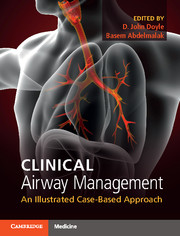Book contents
- Clinical Airway ManagementAn Illustrated Case-Based Approach
- Clinical Airway Management
- Copyright page
- Dedication
- Contents
- Contributors
- Foreword
- Preface
- Acknowledgments
- Section 1 Introduction
- Section 2 Basic Airway Management
- Section 3 The Anticipated Difficult Airway
- 12 Awake Intubation Made Easy
- 13 Airway Management for a Supraglottic Tumor Surgery
- 14 Intubation Through a Bloody Airway Using an SGA and an Aintree Catheter
- 15 Intubation Through a Supraglottic Airway Using a Video Stylet
- 16 Double Lumen Tube in a Known Difficult Airway Patient
- 17 Airway Management for the OSA Patient
- 18 Management of Angioedema and Stridor: Use of Heliox
- 19 Airway Management for Robotic Tongue Base Resection
- 20 Ankylosing Spondylitis: Intubation Using a Lightwand
- 21 Airway Management for Laryngeal Papillomatosis Surgery
- 22 Foreign Body Removal from a Child's Airway
- 23 Airway Management in a Patient with Pierre Robin Sequence
- Section 4 The Unanticipated Difficult Airway
- Section 5 Lower Airway Management
- Section 6 Airway Emergencies and Special Situations
- Section 7 When the Airway Goes Bad
- Appendix: The Art and Science of Awake Fiberoptic Intubation
- Index
- References
21 - Airway Management for Laryngeal Papillomatosis Surgery
from Section 3 - The Anticipated Difficult Airway
Published online by Cambridge University Press: 03 March 2017
- Clinical Airway ManagementAn Illustrated Case-Based Approach
- Clinical Airway Management
- Copyright page
- Dedication
- Contents
- Contributors
- Foreword
- Preface
- Acknowledgments
- Section 1 Introduction
- Section 2 Basic Airway Management
- Section 3 The Anticipated Difficult Airway
- 12 Awake Intubation Made Easy
- 13 Airway Management for a Supraglottic Tumor Surgery
- 14 Intubation Through a Bloody Airway Using an SGA and an Aintree Catheter
- 15 Intubation Through a Supraglottic Airway Using a Video Stylet
- 16 Double Lumen Tube in a Known Difficult Airway Patient
- 17 Airway Management for the OSA Patient
- 18 Management of Angioedema and Stridor: Use of Heliox
- 19 Airway Management for Robotic Tongue Base Resection
- 20 Ankylosing Spondylitis: Intubation Using a Lightwand
- 21 Airway Management for Laryngeal Papillomatosis Surgery
- 22 Foreign Body Removal from a Child's Airway
- 23 Airway Management in a Patient with Pierre Robin Sequence
- Section 4 The Unanticipated Difficult Airway
- Section 5 Lower Airway Management
- Section 6 Airway Emergencies and Special Situations
- Section 7 When the Airway Goes Bad
- Appendix: The Art and Science of Awake Fiberoptic Intubation
- Index
- References
- Type
- Chapter
- Information
- Clinical Airway ManagementAn Illustrated Case-Based Approach, pp. 112 - 116Publisher: Cambridge University PressPrint publication year: 2000



